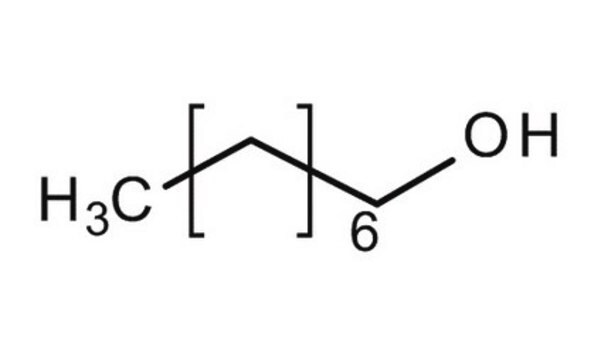150584
1-Decanol
98%
Synonym(s):
n-Decyl alcohol, Alcohol C10
About This Item
Recommended Products
vapor density
4.5 (vs air)
Quality Level
vapor pressure
1 mmHg ( 70 °C)
8.25 mmHg ( 100 °C)
Assay
98%
form
liquid
autoignition temp.
550 °F
refractive index
n20/D 1.437 (lit.)
bp
231 °C (lit.)
mp
5-7 °C (lit.)
solubility
H2O: slightly soluble 0.0211 g/L at 20 °C
density
0.829 g/mL at 25 °C (lit.)
functional group
hydroxyl
SMILES string
CCCCCCCCCCO
InChI
1S/C10H22O/c1-2-3-4-5-6-7-8-9-10-11/h11H,2-10H2,1H3
InChI key
MWKFXSUHUHTGQN-UHFFFAOYSA-N
Looking for similar products? Visit Product Comparison Guide
Related Categories
Application
Signal Word
Warning
Hazard Statements
Precautionary Statements
Hazard Classifications
Aquatic Chronic 3 - Eye Irrit. 2
Storage Class Code
10 - Combustible liquids
WGK
WGK 1
Flash Point(F)
203.0 °F - Pensky-Martens closed cup
Flash Point(C)
95 °C - Pensky-Martens closed cup
Personal Protective Equipment
Choose from one of the most recent versions:
Already Own This Product?
Find documentation for the products that you have recently purchased in the Document Library.
Customers Also Viewed
Global Trade Item Number
| SKU | GTIN |
|---|---|
| 150584-2.5L | |
| 150584-25G | |
| 150584-3KG | 4061838738905 |
| 150584-500G | 4061838738912 |
| 150584-500ML |
Our team of scientists has experience in all areas of research including Life Science, Material Science, Chemical Synthesis, Chromatography, Analytical and many others.
Contact Technical Service












